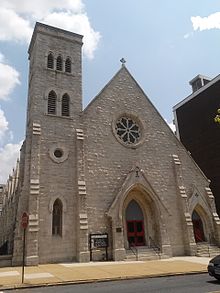
The Episcopal Diocese of Washington is a diocese of the Episcopal Church covering Washington, D.C., and nearby counties of Maryland in the United States. With a membership of over 38,000, the diocese is led by the Bishop of Washington, Mariann Budde. It is home to Washington National Cathedral, which is the seat of both the diocesan bishop and the Presiding Bishop of the Episcopal Church.

The Episcopal Diocese of Maryland forms part of Province 3 of the Episcopal Church in the United States of America. Having been divided twice, it no longer includes all of Maryland and now consists of the central, northern, and western Maryland counties of Allegany, Anne Arundel, Baltimore, Calvert, Carroll, Frederick, Garrett, Harford, Howard, and Washington, as well as the independent city of Baltimore.

Michael Bruce Curry is an American bishop who is the 27th and current presiding bishop and primate of The Episcopal Church. Elected in 2015, he is the first African American to serve as presiding bishop in The Episcopal Church. He was previously bishop of the Diocese of North Carolina.

The Church of the Ascension and Saint Agnes is an Episcopal church building located at 1215 Massachusetts Avenue in Northwest Washington, D.C., US. The current structure built in 1874 as the Church of the Ascension was added to the National Register of Historic Places in 1984. In the late 1940s, the Church of the Ascension merged with the nearby St. Agnes Episcopal Church and adopted its present name, under which it has continued as an active parish in the Episcopal Diocese of Washington.

Thomas John Claggett was the first bishop of the newly formed American Episcopal Church to be consecrated on American soil and the first bishop of the recently established (1780) Diocese of Maryland.

John Prentiss Kewley Henshaw was the fourth Bishop of Rhode Island in the Episcopal Church in the United States of America, and the first to hold that position alone.

Christ Church — known also as Christ Church, Washington Parish or Christ Church on Capitol Hill — is a historic Episcopal church located at 620 G Street SE in Washington, D.C., USA. The church is also called Christ Church, Navy Yard, because of its proximity to the Washington Navy Yard and the nearby U.S. Marine Barracks.
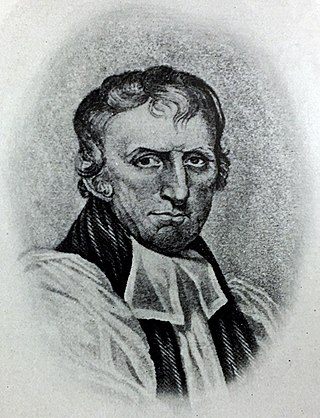
James Kemp was the second bishop of the Diocese of Maryland, US, from 1816 to 1827.

All Saints Episcopal Church is a historic Episcopal church in Appleton, Wisconsin. A parish in the Diocese of Fond du Lac, it is the only Episcopal church in Appleton. The congregation first met circa 1854 and organized in 1856. The current church building was consecrated in 1905.

The African Episcopal Church of St. Thomas (AECST) was founded in 1792 in Philadelphia, Pennsylvania, as the first black Episcopal Church in the United States. Its congregation developed from the Free African Society, a non-denominational group formed by blacks who had left St. George's Methodist Church because of discrimination and segregation by class. They were led by Absalom Jones, a free black and lay Methodist preacher. As his congregation became established, he was ordained in 1802 by Presiding Bishop William White as the first black priest in the Episcopal Church. Bishop White also ordained William Levington as a deacon at this church, although he soon became a missionary in the South, establishing St. James Church in Baltimore in 1824.
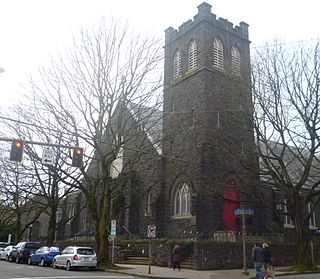
Trinity Episcopal Cathedral in Portland, Oregon is a progressive Episcopal congregation and the seat of the Episcopal Diocese of Oregon of The Episcopal Church. The cathedral is located at 147 NW 19th Avenue in Portland, Oregon, in the Northwest District.

St. Paul's Protestant Episcopal Church, more commonly called Old St. Paul's Church today, is a historic Episcopal church located at 233 North Charles Street at the southeast corner with East Saratoga Street, in Baltimore, Maryland, near "Cathedral Hill" on the northern edge of the downtown central business district to the south and the Mount Vernon-Belevedere cultural/historic neighborhood to the north. It was founded in 1692 as the parish church for the "Patapsco Parish", one of the "original 30 parishes" of the old Church of England in colonial Maryland.

William Douglass (1804–1862) was an abolitionist and Episcopal priest. He preached for peace, racial equality, and education in the religious community.

George Freeman Bragg was an African-American priest, journalist, social activist and historian. The twelfth African American ordained as a priest in the Episcopal Church of the United States, he worked against racial discrimination and for interracial harmony, both within and outside of his church.
William Levington was an African-American clergyman and teacher. The third African American ordained as a priest in the Episcopal Church of the United States, he established the first African-American congregation south of the Mason–Dixon line, and worked to educate African American youth.
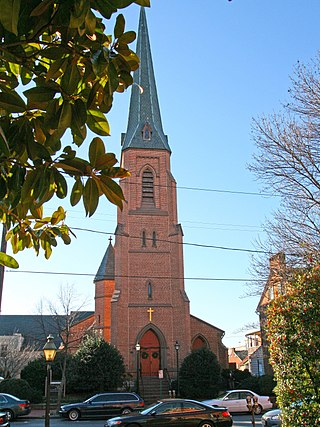
All Saints Church, or All Saints Episcopal Church, founded in 1742, is a historic Episcopal church now located at 106 West Church Street in the Historic District of Frederick, Maryland. It is the seat of All Saints Parish, Diocese of Maryland, which covers most of Frederick County, Maryland and once covered most of Western Maryland.

Lafayette Square, is a historic city park and district in the Sandtown-Winchester area of West Baltimore, Maryland. It is bounded by Lanvale Street and Lafayette, Arlington, and Carrollton Avenues.

St. James's Episcopal Church is the third oldest Episcopal congregation in Richmond, Virginia. Only the older St. John's Episcopal Church on Church Hill also remains an active congregation.
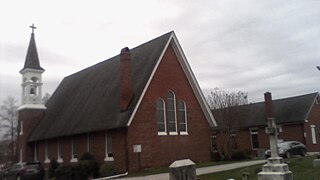
St. John's Episcopal Church, Zion Parish in Beltsville, Maryland is a historic place of worship whose congregation dates back more than two centuries.

Grace & St. Peter's Church is an Anglo-Catholic Episcopal parish in the city of Baltimore, in the Episcopal Diocese of Maryland. The congregation is the product of the 1912 amalgamation of two earlier parishes, St. Peter's Church and Grace Church. Its building, constructed in Brownstone, is an elaborate example of English Gothic Revival architecture dating from 1852. Today, Grace & St. Peter's is distinguished by its Anglo-Catholic liturgy and professional choir. From 1940 to 2020, it was also home to the Wilkes School at Grace & St. Peter's, an Episcopal day school which closed in the midst of the COVID-19 pandemic.
